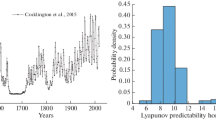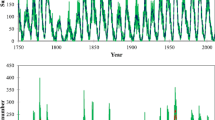Abstract
Solar activity at decadal time scales is characterised by persistent periodic patterns with global effects on the Earth’s climate. This article deals with the analysis and prediction of the revised monthly sunspot numbers, adopting a recently proposed time-series model for long-range dependent cycles. The methodology is based on the maximum-likelihood estimate of the model parameters and provides optimal signal extraction filters for cycle estimation and prediction. The analysis suggests the presence of stationary cyclical long memory in the sunspot-generating process. Moreover, our formulation provides a reliable method for solar-cycle predictions, yielding forecasts of the future Cycle 25. In particular, we claim a main peak will occur in early 2024 with an amplitude of 114 and an end of the cycle in early 2030.









Similar content being viewed by others
Data Availability
The datasets generated and/or analyzed during the current study are available from the corresponding author on reasonable request.
Notes
The optimal values of the power and location parameters in the Box–Cox transformation have been obtained via a grid search procedure over values of \(\nu _{1}\) in the range \([0,1]\) with step 0.05 and values of \(\nu _{2}\) in the range \([0,5]\) with step 0.25. Figure 3 shows the log-likelihood of the untransformed series \(R_{t}\) as a function of the Box–Cox parameters, for the model selected and discussed later in this section. The values that maximise the function resulted in \(\nu _{1}=0.4\) and \(\nu _{2}=0.0\). Consequently, there is no need to introduce a location shift and the power transformation parameter is not far from 0.5. Recall that the log-likelihood of the raw data is obtained via the sum between the likelihood of the transformed series \(y_{t}\) in Equation (8), maximised with respect to \(\boldsymbol {\theta }\), plus the log of the Jacobian of the transformation, given by \((\nu _{1}-1) \sum _{t=1}^{n} \log (R_{t} + \nu _{2})\) (see Box and Cox, 1964, for further details).
References
Ahtola, J., Tiao, G.C.: 1987, Distributions of least squares estimators of autoregressive parameters for a process with complex roots on the unit circle. J. Time Ser. Anal. 8, 1. DOI.
Andel, J.: 1986, Long memory time-series models. Kybernetika 22, 105. http://eudml.org/doc/28174.
Artiach, M., Arteche, J.: 2011, Estimation of the frequency in cyclical long-memory series. J. Stat. Comput. Simul. 81, 1627. DOI.
Atkinson, A.C.: 1985, Plots, Transformations, and Regression, Oxford University Press, Oxford. DOI.
Atkinson, A.C., Pericchi, L.R., Smith, R.L.: 1991, Grouped likelihood for the shifted power transformation. J. Roy. Stat. Soc. B 53, 473. DOI.
Beran, J.: 1994, Statistics for Long-Memory Processes 61, CRC Press, Boca Raton. DOI.
Bierens, H.J.: 2001, Complex unit roots and business cycles: Are they real? Econom. Theory 17, 962. DOI.
Bloomfield, P.: 1973, An exponential model for the spectrum of a scalar time series. Biometrika 60, 217. DOI.
Box, G.E.P., Cox, D.R.: 1964, An analysis of transformations. J. Roy. Stat. Soc. B 26, 211. https://www.jstor.org/stable/2984418.
Box, G.E.P., Jenkins, G.M., Reinsel, G.C., Ljung, G.M.: 2015, Time Series Analysis: Forecasting and Control, 5th edn., Wiley Series in Probability and Statistics, Wiley, New York. DOI.
Brockwell, P.J., Davis, R.A.: 1991, Time Series: Theory and Methods: Theory and Methods, Springer, Berlin. DOI.
Chung, C.-F.: 1996, A generalized fractionally integrated autoregressive moving-average process. J. Time Ser. Anal. 17, 111. DOI.
Dissanayake, G.S., Peiris, M.S., Proietti, T.: 2016, State space modelling of Gegenbauer processes with long memory. Comput. Stat. Data Anal. 100, 115. DOI.
Dissanayake, G., Peiris, M., Proietti, T., et al.: 2018, Fractionally differenced Gegenbauer processes with long memory: A review. Stat. Sci. 33, 413. DOI.
Gil-Alana, L.A.: 2009, Time series modelling of sunspot numbers using long-range cyclical dependence. Solar Phys. 257, 371. DOI.
Gleissberg, W.: 1939, A long-periodic fluctuation of the sun-spot numbers. Observatory 62, 158. ADS.
Gray, H.L., Zhang, N.-F., Woodward, W.A.: 1989, On generalized fractional processes. J. Time Ser. Anal. 10, 233. DOI.
Hassler, U.: 2019, Time Series Analysis with Long Memory in View, Wiley, New York. DOI.
Hazra, S., Brun, A.S., Nandy, D.: 2020, Does the mean-field \(\alpha\) effect have any impact on the memory of the solar cycle? Astron. Astrophys. 642, A51. DOI.
Hiremath, K.M.: 2008, Prediction of solar cycle 24 and beyond. Astrophys. Space Sci. 314, 45. DOI.
Hosking, J.R.M.: 1981, Fractional differencing. Biometrika 68, 165. DOI.
Jensen, J.L.: 1993, Comments on nonparametric predictions of sunspot numbers. Astron. J. 105, 350. DOI.
Khashei, M., Bijari, M.: 2011, A novel hybridization of artificial neural networks and ARIMA models for time series forecasting. Appl. Soft Comput. 11, 2664. The Impact of Soft Computing for the Progress of Artificial Intelligence. DOI.
Kolláth, Z., Oláh, K.: 2009, Multiple and changing cycles of active stars - I. Methods of analysis and application to the solar cycles. Astron. Astrophys. 501, 695. DOI.
Mandelbrot, B.B., Wallis, J.R.: 1969, Some long-run properties of geophysical records. Water Resour. Res. 5, 321. DOI.
Morris, M.J.: 1977, Forecasting the sunspot cycle. J. Roy. Stat. Soc. 140, 437. DOI.
Muñoz-Jaramillo, A., Dasi-Espuig, M., Balmaceda, L.A., DeLuca, E.E.: 2013, Solar cycle propagation, memory, and prediction: Insights from a century of magnetic proxies. Astrophys. J. 767, L25. DOI.
Oliver, R., Ballester, J.L.: 1996, Rescaled range analysis of the asymmetry of solar activity. Solar Phys. 169, 215. DOI.
Oliver, R., Ballester, J.L.: 1998, Is there memory in solar activity? Phys. Rev. E 58, 5650. DOI.
Oppenheim, G., Viano, M.-C.: 2004, Aggregation of random parameters Ornstein-Uhlenbeck or AR processes: Some convergence results. J. Time Ser. Anal. 25, 335. DOI.
Pesnell, W.D.: 2012, Solar cycle predictions (invited review). Solar Phys. 281, 507. DOI.
Petrovay, K.: 2010, Solar cycle prediction. Living Rev. Solar Phys. 7, 6. DOI.
Petrovay, K.: 2020, Solar cycle prediction. Living Rev. Solar Phys. 17, 2. DOI.
Proietti, T., Giovannelli, A.: 2018, A Durbin–Levinson regularized estimator of high-dimensional autocovariance matrices. Biometrika 105, 783. DOI.
Proietti, T., Maddanu, F.: 2021, Modelling cycles in climate series: The fractional Sinusoidal Waveform process. CEIS Working Paper No. 518, available at SSRN: DOI.
Robinson, P.M.: 1994, Efficient tests of nonstationary hypotheses. J. Am. Stat. Assoc. 89, 1420. DOI.
Schatten, K.H., Pesnell, W.D.: 1993, An early solar dynamo prediction: Cycle 23 - cycle 22. Geophys. Res. Lett. 20, 2275. DOI.
Tong, H.: 1990, Non-linear Time Series: A Dynamical System Approach, Clarendon Press, Oxford. DOI.
Usoskin, I.G.: 2017, A history of solar activity over millennia. Living Rev. Solar Phys. 14, 3. DOI.
Werner, R.: 2012, Sunspot number prediction by an autoregressive model. Sun Geosph. 7, 75. ADS.
Woodward, W.A., Cheng, Q.C., Gray, H.L.: 1998, A \(k\)-factor GARMA long-memory model. J. Time Ser. Anal. 19, 485. DOI.
Yu, Y., van Dyk, D.A., Kashyap, V.L., Young, C.A.: 2012, A Bayesian analysis of the correlations among sunspot cycles. Solar Phys. 281, 847. DOI.
Zhang, G.P.: 2003, Time series forecasting using a hybrid ARIMA and neural network model. Neurocomputing 50, 159. DOI.
Acknowledgments
This work was funded by the CY Initiative of Excellence (grant “Investissements d’Avenir” ANR-16-IDEX-0008), Project “EcoDep” PSI-AAP2020-0000000013.
Author information
Authors and Affiliations
Contributions
The authors did not receive support from any private organization for the submitted work. The data and the code developed for this work are available upon request.
Corresponding author
Ethics declarations
Conflict of Interest
The authors have no conflicts of interest to declare that are relevant to the content of this article.
Additional information
Publisher’s Note
Springer Nature remains neutral with regard to jurisdictional claims in published maps and institutional affiliations.
Appendix: Testing for Nonstationary Cycles
Appendix: Testing for Nonstationary Cycles
This appendix illustrates how the test for a nonstationary cycle at a known frequency proposed by Robinson (1994) is carried out in our case. Consider the linear regression model with fSW errors
where \(\mathbf{x}_{t}\) is a vector of exogenous variables and \([\eta _{t}, \eta ^{*}_{t}] \sim N(0,\sigma ^{2}_{\eta }I_{2}) \).
The Lagrange Multiplier (LM) test by Robinson (1994) of the null hypothesis \(H_{0}: d_{0} = 0.5\) against \(H_{1}: d_{0} < 0.5\), is implemented as follows. Considering the complex fractional noise representation of the fSW process (see Proietti and Maddanu, 2021), we regress \(\Phi (L)y_{t}\) on \(\boldsymbol {w}_{t}=\Phi (L) \mathbf{x}_{t}\) where \(\Phi (L) = (1 - 2 \cos (\lambda )L + L^{2})^{d_{0}}\). The resulting ordinary least-square (OLS) estimator \(\hat{\boldsymbol {\beta }}= (\sum _{t=1}^{n} \boldsymbol {w}_{t} \boldsymbol {w}_{t}')^{-1}\sum _{t=1}^{n} \boldsymbol {w}_{t}\Phi (L)y_{t}\) is then used to compute the residuals \(\hat{u}_{t} = \Phi (L)y_{t} - \hat{\boldsymbol {\beta }}'\boldsymbol {w}_{t}\) and the corresponding periodogram \(I_{\hat{u}}(\omega _{j})=\frac{1}{2 \pi n} |\sum _{t=1}^{n} \hat{u}_{t} e^{-\imath \omega _{j} t} |^{2} \).
The LM statistic is
where
and
with
while the \(\sigma ^{2}_{\eta }\) parameter is estimated as
where \(b_{0}\) is the intercept estimated via the linear regression \(\ln (2\pi ) I_{\hat{u}}(\omega _{j}) + c= b_{0}+ 2 \sum _{i=1}^{K} b_{i} \cos (i \omega _{j}) + e_{t}\) (\(c=0.57721\) is Euler’s constant), see Bloomfield (1973), where \(K\) is chosen according to the Akaike information criterion.
Robinson (1994) shows that the LM statistic has a standard chi-square distribution with one degree of freedom.
Rights and permissions
About this article
Cite this article
Maddanu, F., Proietti, T. Modelling Persistent Cycles in Solar Activity. Sol Phys 297, 13 (2022). https://doi.org/10.1007/s11207-021-01943-w
Received:
Accepted:
Published:
DOI: https://doi.org/10.1007/s11207-021-01943-w




